| Index |
| S.No | Topic | Page No |
| Daily Hindu Analysis (YouTube) |
| 1. | Why do elephants face a jumbo challenge? |
|
| 2. | Microbial link between arsenic in soil, lower rice yield uncovered |
|
| 3. | Why emergency care needs to be prioritised |
|
| 4. | Women form 49% of total hospital admissions with Ayushman Bharat |
|
| 5. | Manufacturers pass on GST cut benefits across 54 daily use items: Finance Minister |
|
| 6. | At IMO, 57 nations vote for delaying framework for carbon-free shipping |
|
| 7. | Chandrayaan-2 makes first-ever observations on lunar exosphere: ISRO |
|
| 8. | The most ancient Indian wolf is set to be a new species |
|
| 9. | Gudalur’s violet revival: the kurinji blooms again |
|
| Daily Current Affairs (App) |
| 10. | New Development Bank: Pakistan Seeks China’s Help for Membership |
|
| 11. | We Rise Initiative: Empowering Women Entrepreneurs |
|
| 12. | Food and Agriculture Organization: 80 Years of Partnership with India |
|
| 13. | IN-RoKN Exercise: Strengthening Naval Ties Between India and South Korea |
|
Why do elephants face a jumbo challenge?
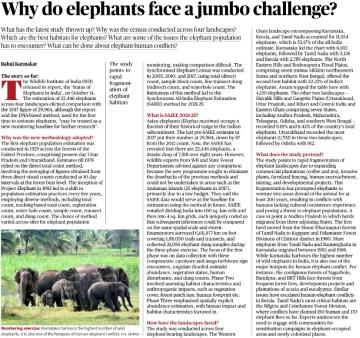
Syllabus Mapping:
- GS Paper 3: Environment – Conservation, Biodiversity, Wildlife Protection, Environmental Pollution, and Degradation.
Context: The Wildlife Institute of India (WII) recently released the ‘Status of Elephants in India, 2021–25’ report, providing a comprehensive estimate of India’s elephant population using a new DNA-based methodology. The study highlights a rapid decline in population, fragmentation of elephant habitats, and rising human-elephant conflicts, calling for urgent conservation measures.
What is the Report About? The Synchronized All-India Elephant Estimation (SAIEE) 2021–25 was conducted across four major elephant landscapes:
1. Western Ghats
2. North Eastern Hills and Brahmaputra Flood Plains
3. Shivalik Hills and Gangetic Plains
4. Central India and Eastern Ghats The study estimates 22,446 elephants, a sharp decline from 29,964 recorded in 2017 — a drop of nearly 7,500 elephants (about 25%).
Why Was a New Methodology Adopted?
- Earlier censuses (since 1929) relied on direct count methods, such as visual sightings, dung counts, and waterhole observations.
- These older methods lacked uniformity and scientific accuracy.
- The DNA-based estimation used in 2021–25 offers higher precision by analysing genetic material from dung samples, ensuring individual identification and avoiding duplication.
- It also provides a baseline for future monitoring using uniform scientific parameters across regions.
Key Findings of the Report: 1. Population Distribution
- Western Ghats Landscape (Karnataka, Kerala, Tamil Nadu):
- Accounts for 53.7% of total elephants (11,934).
- Karnataka leads with 6,013 elephants, followed by Tamil Nadu (3,136) and Kerala (2,785).
- North Eastern Hills and Brahmaputra Flood Plains:
- Second highest population (22.2%) with 4,159 elephants, mainly in Assam and Arunachal Pradesh.
- Shivalik Hills and Gangetic Plains:
- Include Uttarakhand, Uttar Pradesh, and Bihar — smaller, fragmented populations.
- Central India and Eastern Ghats:
- Spread across Odisha, Chhattisgarh, and Jharkhand.
- Odisha alone hosts 912 elephants, but faces intense human-wildlife conflict.
2. Reasons for Decline - Habitat fragmentation and loss:
- Expansion of agriculture, tea and coffee plantations, and mining in elephant corridors.
- Linear infrastructure:
- Highways, rail lines, and power lines disrupt migratory routes.
- Human encroachment:
- Urban expansion near forest fringes reduces safe habitat zones.
- Poaching and electrocution:
- Ongoing threats in regions with weak enforcement.
- Climate change:
- Altering forest composition and water availability, affecting food sources.
3. Human–Elephant Conflict - Increasing overlap between human settlements and elephant corridors has led to frequent crop raiding, property damage, and loss of lives.
- For example:
- Bannergatta National Park (Karnataka) and Valparai (Tamil Nadu) record multiple annual fatalities.
- The Niligiri Biosphere Reserve remains a major conflict hotspot.
- Conflicts are more acute during migration seasons, when elephants traverse between fragmented forest patches in search of food and water.
4. Conservation and Policy Measures Government Initiatives: - Project Elephant (1992):
- Focus on protection, habitat restoration, and corridor preservation.
- Elephant Corridors Initiative:
- Identification of 101 critical elephant corridors across India.
- Gaj Yatra Campaign:
- Nationwide awareness drive for elephant conservation.
- Eco-sensitive Zones (ESZs):
- Buffer protection around elephant reserves.
New Recommendations: - Integrate land-use planning with wildlife corridors in infrastructure projects.
- Introduce landscape-level management rather than isolated forest protection.
- Employ early-warning systems using drones and sensors to prevent human-elephant clashes.
- Encourage community participation in mitigation through compensation schemes and sustainable livelihoods.
Way Forward: 1. Habitat Restoration: o Reconnect fragmented corridors through afforestation and land purchase schemes.
2. Technology Integration: o Use GPS-collared tracking, AI-based surveillance, and acoustic sensors for elephant monitoring.
3. Community Involvement: o Promote coexistence via eco-tourism, education, and fair compensation policies.
4. Legal Protection: o Strengthen enforcement under the Wildlife (Protection) Act, 1972 and ensure ecological impact assessments for new projects.
5. Regional Cooperation: o Encourage cross-border coordination with Nepal, Bhutan, and Bangladesh for migratory herds.
UPSC Mains: Q. "The fragmentation of elephant habitats has intensified human–elephant conflicts in India. Examine the underlying causes and suggest measures to ensure coexistence."
Microbial link between arsenic in soil, lower rice yield uncovered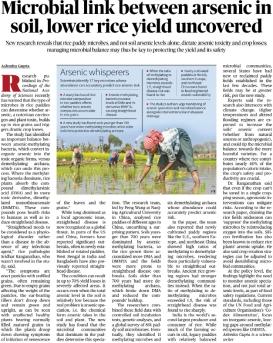
Syllabus Mapping:
GS Paper 3: Science and Technology – Developments in biotechnology and their applications, Environment – Pollution, soil degradation, and conservation practices, Agriculture – Issues of productivity, soil health, and sustainable farming practices.
Context: A new study published in the Proceedings of the National Academy of Sciences (PNAS) has uncovered that microbial composition in rice paddies, and not merely soil arsenic levels, plays a decisive role in arsenic toxicity, crop yield, and food safety.
The findings hold major implications for agricultural practices in arsenic-prone regions like West Bengal, Bihar, Uttar Pradesh, and parts of China and Bangladesh, where rice is a staple crop.
What is the Issue All About?
- Arsenic contamination in paddy fields has long been linked to reduced rice yield and arsenic accumulation in grains, posing health risks to millions dependent on rice.
- The new research shows that the type of microbes in the soil determines whether arsenic is converted into toxic forms or neutralised.
- Managing this microbial balance can therefore be the key to maintaining both productivity and food safety.
Key Scientific Findings: 1. Microbial Role in Arsenic Transformation
- Arsenic-methylating bacteria convert organic arsenic into its toxic forms, such as dimethylarsinic acid (DMA) and dimethylarsonate (DMMTA).
- Demethylating archaea, on the other hand, detoxify arsenic by breaking these compounds down.
- The balance between these two microbial types determines the extent of arsenic buildup in rice grains and the likelihood of disease outbreaks like straighthead disease.
2. Straighthead Disease - A physiological disorder in rice where grains remain empty or deformed despite normal growth.
- The study shows that high arsenic-methylating activity leads to more DMA and DMMTA accumulation, increasing the risk of the disease.
3. Age of Soils and Arsenic Accumulation - Soils younger than 700 years tend to have more arsenic-methylating bacteria, making them more prone to toxic buildup.
- Older soils, dominated by demethylating microbes, display natural resilience against arsenic toxicity.
4. Global Relevance - The study covered rice fields in China, but the findings extend to newly cultivated paddy areas in the U.S., southern Europe, and northeast China, all showing similar microbial patterns.
- In India, eastern states that rely heavily on groundwater irrigation are particularly vulnerable, as arsenic contamination in groundwater directly affects soil microbial ecology.
5. Arsenic and Food Safety - Arsenic compounds like DMA and DMMTA are classified as carcinogenic, and rice contributes nearly 40% of dietary arsenic intake globally.
- High levels of toxic arsenic in rice pose risks of cancer, neurological disorders, and cardiovascular diseases.
6. Implications for Agriculture: Short-Term Measures: - Optimising water management: Controlled irrigation and midseason drainage can reduce arsenic solubility.
- Balanced fertiliser use: Excessive nitrogen can stimulate methylating microbes; soil fertility practices must avoid altering microbial ratios.
Long-Term Measures: - Soil microbiome management through bioengineering or organic amendments.
- Development of arsenic-resistant rice varieties through genetic research.
- Inclusion of arsenic mitigation in climate adaptation policies, as changing temperature and flooding regimes can alter microbial ecology.
Policy & Global Context: - India is the second-largest rice producer and top consumer globally; arsenic contamination threatens food security and export competitiveness.
- The findings align with FAO and WHO standards, which set strict limits for inorganic arsenic in food products.
- At the national level, it calls for integrating arsenic-safe agriculture within programmes like National Food Security Mission and Pradhan Mantri Krishi Sinchayee Yojana (PMKSY).
Significance: - Shifts focus from chemical testing to biological soil health, recognising microbes as critical regulators of soil safety.
- Enhances understanding of soil–microbe–plant interactions, a crucial area for sustainable agriculture.
- Reinforces the need for multidisciplinary soil management integrating microbiology, climate science, and agricultural policy.
Way Forward: 1. Promote microbiome-based soil management — through organic farming, crop rotation, and bio-fertilisers.
2. Encourage research on microbial ecology in arsenic-affected regions. 3. Set up early warning systems for soil toxicity in high-risk zones.
4. Integrate arsenic mitigation into rural health and nutrition policies to reduce long-term exposure risks.
UPSC Mains: Q. “Recent research highlights that soil microbes, rather than arsenic levels alone, determine crop yield and food safety. Discuss how understanding microbial ecology can help mitigate agricultural and public health challenges in India.”
Why emergency care needs to be prioritised
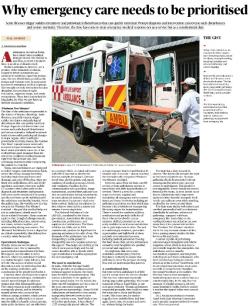
Syllabus Mapping:
- GS Paper 2: Governance – Issues relating to health, government policies, and service delivery mechanisms.
Context: Acute medical emergencies such as heart attacks, strokes, or trauma require immediate medical response to prevent death or disability. The article emphasizes that emergency care should be treated as a constitutional duty, not merely a healthcare service. In India, despite improvements in ambulance infrastructure, delays, lack of trained personnel, and poor system coordination continue to cause avoidable fatalities.
What Is It All About?
Emergency care is the first line of medical response during sudden circulatory or pathological disturbances. It involves prompt diagnosis, stabilization, and intervention — often within minutes.
Modern ambulances, equipped with life-support systems, symbolise technological advancement in healthcare. However, their effectiveness depends on time-sensitive coordination, trained responders, and systemic support.
The “Platinum Ten Minutes” Concept - This principle highlights that the first 10 minutes after an emergency are crucial for life-saving intervention.
- Originating from trauma and cardiac emergency protocols, it underscores that rapid diagnosis, stabilization, and transport can drastically reduce preventable mortality.
- The world has now evolved from “Golden Hour” to “Platinum Ten Minutes,” recognizing the importance of ultra-rapid response mechanisms.
India’s Emergency Care Landscape 1. Ambulance Infrastructure: o India’s emergency medical response has improved with schemes like 108 Emergency Services and National Health Mission support. o Most ambulances are now equipped with oxygen, defibrillators, ECG, IV fluids, and basic trauma management tools.
2. Response Time Challenge: o Despite better equipment, India’s average ambulance response time remains over 15 minutes, while the international benchmark is under 4 minutes. o Rural areas suffer from lack of ambulance availability, GPS tracking, and poor road connectivity. 3. Skill Gap: o Many ambulance drivers lack paramedic or emergency medical technician (EMT) training. o Even in urban areas, there are limited trained personnel per capita to handle mass emergencies.
4. Operational Deficiencies: o No national standardization in emergency response protocols. o Absence of integrated command centres for triage, dispatch, and coordination across hospitals.
What the Article Emphasizes
1. Emergency Care as a Public Right
- Access to timely emergency medical care must be treated as a constitutional right, as part of the right to life under Article 21.
- State governments must ensure universal emergency coverage, especially for vulnerable populations and remote regions.
2. Need for Regulation and Standards - The article calls for:
- National Ambulance Standards for design, staffing, and equipment.
- Uniform training certification for EMTs and paramedics.
- Regulatory oversight by health authorities to ensure quality emergency services.
3. Integration with Disaster Response - Emergency systems should align with disaster management frameworks, capable of handling mass casualty situations such as accidents, stampedes, or floods.
4. The Role of Private and Public Coordination - Private hospitals, which often possess better trauma infrastructure, must be integrated into state emergency networks through public-private partnerships (PPP).
- Referral linkages between ambulance dispatch and hospitals can prevent unnecessary delays.
Way Forward 1. Policy Integration: o Establish a National Emergency Care Authority under the Ministry of Health. o Develop National Emergency Response Standards (NERS) for all states.
2. Capacity Building: o Mandatory training and certification for all emergency responders. o Expansion of emergency medicine departments in medical colleges.
3. Technology and Innovation: o Use of AI-enabled tracking, telemedicine, and mobile apps for emergency triage and nearest-hospital mapping. o Integrate GIS-based routing for faster response times.
4. Public Awareness: o Citizens must be educated about first-aid response, CPR, and emergency hotline use (112). o Encourage a community first responder model, similar to rural fire services. Significance:
- Strengthening emergency medical care is central to achieving Universal Health Coverage (UHC).
- It enhances India’s disaster preparedness, supports the Ayushman Bharat vision, and aligns with the Sustainable Development Goal (SDG 3.8) — ensuring access to essential health services.
UPSC Mains: Q. “Emergency medical care should be viewed not merely as a service but as a constitutional right. Discuss the challenges in India’s emergency healthcare system and suggest measures for reform.”
Women form 49% of total hospital admissions with Ayushman Bharat
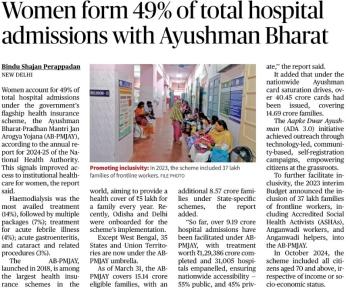
Context:
According to the National Health Authority (NHA) Annual Report (2024–25), women now constitute 49% of total hospital admissions under the Ayushman Bharat Pradhan Mantri Jan Arogya Yojana (AB-PMJAY).
This marks a significant step in improving gender inclusivity and access to institutional healthcare in India’s public health system.
What is the News About?
- The report highlights that nearly half of all hospitalisations under Ayushman Bharat are now women beneficiaries.
- This improvement demonstrates the success of targeted outreach programmes and the government’s efforts to ensure equitable access to healthcare services.
Key Highlights: 1. Increased Female Participation:
Women accounted for 49% of total admissions under AB-PMJAY. o This indicates progress in bridging gender gaps in access to healthcare and financial protection.
2. Most Availed Treatments: Haemodialysis was the most frequently availed treatment (14%), followed by: § Multiple packages (7%) § Acute febrile illness (4%) § Gastroenteritis, cataract, and related procedures (3%)
3. Scheme Coverage and Expansion: o The AB-PMJAY, launched in 2018, provides ₹5 lakh health cover per family per year. o As of March 2024: § Covers 15.14 crore families (approx. 55 crore people). § Includes 35 States and Union Territories (except West Bengal). § Over 9.19 crore hospital admissions completed. § 31,005 empanelled hospitals across India.
4. Recent Developments: 40.45 crore Ayushman cards have been issued, covering 14.69 crore families. o The Aapke Dwar Ayushman (ADA) 3.0 initiative achieved technology-led, community-based outreach, enabling self-registration and inclusivity. o The 2023 Interim Budget expanded the scheme to include 37 lakh families of frontline workers (ASHA, Anganwadi workers, helpers). o In October 2024, citizens aged 70 years and above were included irrespective of income.
Significance:
- Gender Equity in Healthcare: Marks a transformation in women’s healthcare utilisation, addressing long-standing socio-economic barriers.
- Strengthening Social Security: AB-PMJAY continues to be the world’s largest health assurance scheme, ensuring financial protection for vulnerable families.
- Inclusivity: Special efforts to reach frontline workers, senior citizens, and marginalised populations deepen the scheme’s social impact.
- Public Health Milestone: Reflects India’s progress toward Universal Health Coverage (UHC) and aligns with SDG 3 – Good Health and Well-being.
UPSC Prelims: Q. With reference to the
Ayushman Bharat Pradhan Mantri Jan Arogya Yojana (AB-PMJAY), consider the following statements: 1. It provides an annual health cover of ₹10 lakh per family for secondary and tertiary care hospitalisation. 2. The scheme covers only families living below the poverty line as per the Socio-Economic Caste Census (SECC) 2011. 3. Accredited Social Health Activists (ASHAs) and Anganwadi workers have been included as eligible beneficiaries under the scheme. Which of the statements given above is/are correct?
(a) 1 and 2 only
(b) 2 and 3 only
(c) 3 only
(d) 1, 2 and 3
Answer: (b) 2 and 3 only
Manufacturers pass on GST cut benefits across 54 daily use items: Finance Minister
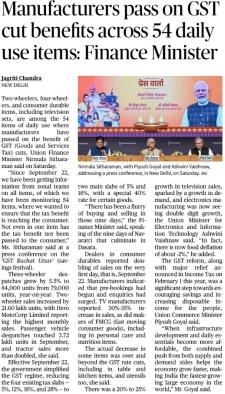
Context:
Union Finance Minister Nirmala Sitharaman announced that manufacturers have passed on the benefits of GST rate cuts across 54 essential and consumer items — including two-wheelers, four-wheelers, electronics, and household goods — under the government’s “GST Bachat Utsav” initiative. · The move follows the simplification of GST slabs — from four (5%, 12%, 18%, and 28%) to two main slabs: 5% and 18%, with a special 40% slab for certain luxury goods. · The aim is to make daily essentials and durables more affordable, stimulate consumer spending, and strengthen supply–demand linkages in the economy. · This announcement reflects the government’s intent to ensure that tax reductions reach the final consumer, thereby boosting demand, consumption, and economic growth.
Key Highlights:
1. Items Covered: o Two-wheelers, three-wheelers, and four-wheelers o Television sets and consumer durables o Tableware, kitchen utensils, personal care, and nutrition products
2. Economic Impact: o Two-wheeler sales rose to 21.6 lakh units in September (highest monthly sales for Hero MotoCorp). o Three-wheeler dispatches up 5.5% YoY. o Passenger vehicle sales at 3.72 lakh units; tractor sales doubled. o Television sales grew by 30–35%, reflecting rising consumer demand. o Electronics manufacturing recorded double-digit growth, supported by higher festive demand.
3. Price Reductions: o Actual price decreases in some goods went beyond GST rate cuts, especially for tableware, utensils, and kitchen items. o The government noted food deflation of about -2%, indicating price stability in essentials.
4. Broader Policy Context: o The GST rate cuts complement earlier income tax reductions (Feb 2025 Budget) aimed at boosting disposable income and consumer spending. o These reforms collectively support India’s trajectory as the fastest-growing large economy in the world. Significance:
- Consumer Welfare: Ensures reduced taxes translate to lower retail prices for end-users.
- Economic Stimulus: Boosts consumption, production, and investment—creating a multiplier effect on GDP.
- Inflation Control: Encourages competition among producers, helping contain inflation while sustaining demand.
- Ease of Doing Business: Simplified GST structure enhances tax compliance and predictability for businesses.
UPSC Prelims: Q. With reference to the Goods and Services Tax (GST) in India, consider the following statements: 1. GST replaced multiple indirect taxes levied by both the Centre and States. 2. Under the GST regime, petroleum and electricity are currently taxed at 28%. 3. GST Council decisions are binding on both the Centre and the States. Which of the statements given above is/are correct?
(a) 1 only
(b) 1 and 3 only
(c) 2 and 3 only
(d) 1, 2 and 3
Answer: (a) 1 only
At IMO, 57 nations vote for delaying framework for carbon-free shipping
Syllabus Mapping: GS Paper 3 – Environment and Ecology: Conservation, pollution control, and environmental impact of industries, International environmental governance – UN agencies, climate agreements.
Context: The International Maritime Organization (IMO) — the UN body responsible for regulating international shipping — has postponed the implementation of a new framework aimed at reducing carbon emissions from global shipping.
The vote, held in London, saw 57 countries supporting a delay of one year on the plan that sought to move the industry away from fossil fuels and achieve net-zero emissions by 2050.
The delay came amid strong opposition from the United States and a few other countries, despite growing global urgency to address climate change in maritime transport.
Background: The IMO and the Carbon-Free Shipping Agenda
- IMO’s Mandate:
The IMO, a specialized UN agency, oversees safety, environmental performance, and legal frameworks for international shipping.
Given that shipping accounts for nearly 3% of global CO₂ emissions, decarbonizing the sector has become crucial for meeting global climate targets under the Paris Agreement. - IMO GHG Strategy (2023):
The 2023 framework envisioned: - At least a 40% reduction in carbon intensity by 2030 (compared to 2008 levels).
- Net-zero GHG emissions by 2050.
- The introduction of a global fuel standard and carbon pricing mechanism for international ships starting 2027.
What Happened at the IMO Meeting? - In April 2025, a sub-committee of the IMO approved the draft framework.
- The final vote was scheduled in October 2025 in London for formal adoption.
- However, after intense lobbying and political pressure, particularly from the United States, Saudi Arabia, and Russia, 57 nations voted to delay the framework’s adoption by a year.
Vote Breakdown: - In favor of delay: 57 countries (including the U.S.)
- Against delay: 49 countries (including EU members and small island nations)
- Abstained: 21 countries
- India’s voting position was not disclosed.
Key Issues and Controversies 1. U.S. Opposition and Pressure:
- The U.S. administration under President Donald Trump strongly opposed the plan, citing potential economic burdens on American consumers and industries.
- Trump labeled the IMO initiative as a “Green New Scam,” urging allied countries to vote against it.
- The U.S. argued that the proposal could raise fuel costs, disrupt global trade, and increase shipping prices for essential goods.
2. Concerns from Developing Nations: - Some developing and oil-exporting countries (e.g., Saudi Arabia, Russia) feared that carbon pricing could make maritime trade disproportionately expensive for poorer economies.
- They argued for “common but differentiated responsibilities” — a core principle of the Paris Agreement — to ensure equity in burden-sharing.
3. Pushback from Climate-Vulnerable Nations: - Small island nations, such as Vanuatu, Tuvalu, and Maldives, condemned the decision.
- They argued that further delay in decarbonizing shipping jeopardizes their survival, as rising sea levels directly threaten their existence.
- Vanuatu’s Climate Minister described the vote as a “failure of global climate leadership.”
Significance of the Framework 1. Global Emission Impact:
- International shipping contributes ~1 billion tonnes of CO₂ annually — more than the emissions of Germany or Japan.
- Without intervention, emissions could increase by 30% by 2050, making it impossible to stay within the 1.5°C global warming limit.
2. Transition Mechanisms Proposed: The IMO’s framework proposed:
- Low-Carbon Fuel Standard (LCFS): Gradual shift from heavy fuel oil to ammonia, methanol, or hydrogen-based fuels.
- Global Carbon Levy: Charging ships based on CO₂ emitted per ton of cargo per mile, to incentivize cleaner fuels.
- Green Shipping Corridors: Routes prioritizing low-emission ships between major ports.
5. Industry Readiness: While several major shipping companies (like Maersk and MSC) have begun adopting green methanol and hybrid propulsion systems, most developing nations lack infrastructure for alternative fuels and retrofit technology.
Why This Delay Matters
- The postponement pushes back critical climate milestones in a sector already lagging in emission reduction.
- It raises questions about global climate governance and the influence of geopolitics on environmental decision-making.
- The decision may also weaken investor confidence in the global transition to clean maritime fuels.
Reactions and Global Implications Outrage from Climate Advocates: - Environmental groups, including Greenpeace and the Clean Shipping Coalition, criticized the vote, calling it a “betrayal of the Paris Agreement.”
- They argue that delaying carbon measures locks in fossil-fuel dependency and worsens climate risks for coastal and island nations.
Future Outlook: - The IMO plans to reconvene in 2026 to finalize the framework.
- Countries like Singapore, which led the delay motion, claim they need more time to evaluate implementation costs and technical feasibility.
- Experts emphasize the need for a just transition — balancing climate goals with trade and economic realities.
India’s Position (Likely Stance) - Though India’s vote was not confirmed, it is likely that India supported flexibility in timelines, given concerns about developing-country competitiveness and the cost of green technology adoption.
- India, however, continues to advocate for capacity building and technology transfer to help developing maritime nations transition sustainably.
UPSC Prelims: Q. Consider the following statements regarding the International Maritime Organization (IMO): 1. The IMO is a specialized agency of the United Nations responsible for regulating shipping safety and preventing marine pollution. 2. The IMO’s headquarters is located in Geneva, Switzerland. 3. The IMO’s GHG Strategy aims to achieve net-zero carbon emissions from global shipping by 2050. Which of the above statements is/are correct?
(a) 1 and 2 only
(b) 2 and 3 only
(c) 1 and 3 only
(d) 1, 2 and 3
Answer: (c) 1 and 3 only
Chandrayaan-2 makes first-ever observations on lunar exosphere: ISRO
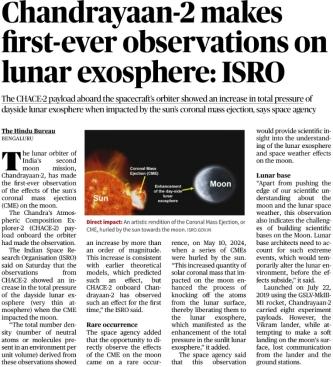
Syllabus Mapping: GS Paper 3 – Science and Technology: Achievements of Indians in science and technology, Awareness in the fields of space, IT, computers, robotics, and nano-technology, Developments and applications of science in everyday life.
Context: India’s second lunar mission, Chandrayaan-2, has achieved a major scientific milestone by making the first-ever observation of the impact of the Sun’s Coronal Mass Ejection (CME) on the lunar exosphere — the Moon’s extremely thin outermost atmospheric layer.
This observation, made by the CHACE-2 (Chandra’s Atmospheric Composition Explorer-2) payload aboard the orbiter, provides new insights into space weather effects on the Moon and implications for future lunar habitats.
What is it All About?
The Indian Space Research Organisation (ISRO) reported that CHACE-2 detected a significant increase in the total pressure of the dayside lunar exosphere when a powerful solar CME event impacted the Moon in May 2024.
This marks the first time such an effect has been observed directly from lunar orbit, confirming theoretical predictions about Sun–Moon interactions and space plasma dynamics.
Understanding the Key Concepts 1. What is the Lunar Exosphere? - The lunar exosphere is the outermost, extremely tenuous layer of gases surrounding the Moon.
- It contains atoms like sodium (Na), potassium (K), helium (He), argon (Ar), and other trace elements that exist at extremely low densities — so much so that they rarely collide with one another.
- It is often referred to as a surface-bound exosphere, where particles are ejected from the lunar surface due to:
- Solar radiation
- Micrometeorite impacts
- Solar wind bombardment
2. What is a Coronal Mass Ejection (CME)? - A CME is a massive burst of plasma and magnetic fields released from the Sun’s corona into space.
- When directed toward celestial bodies, CMEs can disturb their atmospheres or magnetic fields.
- On Earth, such events can trigger geomagnetic storms, disrupt satellites, and cause auroras.
- On the Moon, which lacks a protective magnetic field or dense atmosphere, CMEs directly interact with the surface.
Key Findings from CHACE-2 Observation 1. Observation Date: o The event occurred on May 10, 2024, when a series of CMEs struck the Moon.
2. Major Observation: o The total pressure of the lunar exosphere increased by more than an order of magnitude (i.e., over 10 times higher than normal). o This was caused by atoms being knocked off the lunar surface (a process called sputtering) due to the impact of solar plasma. 3. Scientific Confirmation: o The result aligns with theoretical models that had predicted such an effect but had never been empirically observed before. o Chandrayaan-2’s CHACE-2 payload has now confirmed it for the first time.
Scientific and Strategic Significance
1. Understanding Space Weather
- The findings enhance our understanding of how solar radiation and plasma events affect airless bodies like the Moon.
- It provides crucial data for space weather modelling, which is essential for planning human missions to the lunar surface.
2. Implications for Lunar Base Construction - Future lunar bases (as planned under projects like Artemis or India’s Bharatiya Lunar Programme) will need to account for:
- Sudden increases in surface particle activity.
- Changes in surface charging and radiation exposure during CME events.
- Such variations can impact electronic equipment, solar panels, and human habitats on the Moon.
3. Role of Indian Space Science - This milestone highlights ISRO’s growing role in planetary science and heliophysics (the study of the Sun’s influence on the Solar System).
- It reinforces India’s status as a leading nation in lunar exploration, following Chandrayaan-3’s successful soft landing at the lunar south pole.
About the CHACE-2 Instrument - Full Form: Chandra’s Atmospheric Composition Explorer-2
- Objective: To study the composition and variations in the lunar exosphere.
- Carried Aboard: Chandrayaan-2 Orbiter
- Functionality: Measures neutral atoms and molecules using a quadrupole mass spectrometer, allowing detection of trace elements and gases around the Moon.
About Chandrayaan-2 Mission - Launch Date: July 22, 2019
- Launch Vehicle: GSLV Mk-III M1 (Geosynchronous Satellite Launch Vehicle)
- Components:
- Orbiter – continues to function and send data.
- Vikram Lander – attempted soft landing but lost communication.
- Pragyan Rover – housed within Vikram.
- Despite the lander’s crash, the orbiter continues to perform vital scientific observations, including this latest breakthrough.
UPSC Prelims: Q. With reference to the recent findings from the Chandrayaan-2 mission, consider the following statements: 1. The CHACE-2 payload aboard Chandrayaan-2 orbiter observed the first-ever effect of a solar Coronal Mass Ejection (CME) on the Moon’s exosphere. 2. The lunar exosphere is a dense atmospheric layer that protects the Moon from solar radiation. 3. Coronal Mass Ejections are caused by massive releases of plasma and magnetic fields from the Sun’s corona. Which of the statements given above is/are correct?
(a) 1 and 2 only
(b) 2 and 3 only
(c) 1 and 3 only
(d) 1, 2 and 3
Answer: (c) 1 and 3 only
The most ancient Indian wolf is set to be a new species

Syllabus Mapping:
GS Paper 3: Environment and Ecology: Conservation, environmental pollution and degradation, biodiversity, Wildlife Protection Act and conservation strategies, Human-wildlife conflict and sustainable development balance
Context: The Indian wolf (Canis lupus pallipes), a little-known yet ecologically significant predator inhabiting India’s scrublands and grasslands, is likely to be classified as a new species by the International Union for Conservation of Nature (IUCN).
With an estimated population of just around 3,000 individuals across India and Pakistan, this ancient lineage represents one of the oldest living wolf lineages in the world.
The potential reclassification aims to draw global attention to the species’ conservation needs amid escalating habitat loss, human-wildlife conflict, and climate stress.
About the Indian Wolf
- Scientific Name: Canis lupus pallipes
- Current Classification: Subspecies of the grey wolf (Canis lupus).
- Proposed Change: Recognition as a distinct species based on genetic, ecological, and morphological evidence.
- Habitat: Semi-arid scrublands, grasslands, and open plains across peninsular and northwestern India, extending into Pakistan.
- Population: Estimated at 3,000 individuals.
- IUCN Status: Listed as “Vulnerable”, signifying a high risk of extinction in the wild.
- Protection in India: Included under Schedule I of the Wildlife Protection Act, 1972, ensuring the highest level of legal protection.
Why Is It Being Recognized as a New Species? Recent genetic studies suggest that the Indian wolf is evolutionarily distinct from other grey wolf populations found in Eurasia and North America.
It represents one of the earliest divergent lineages among wolves — a remnant of ancient canids that once roamed across Asia before modern wolf populations evolved.
- It possesses unique mitochondrial DNA and distinct morphological traits, such as:
- Shorter, thinner fur suited for hot, arid climates.
- Smaller body size and a more slender build.
- Adaptations to open, semi-desert habitats unlike the forested or tundra regions preferred by other wolf species.
Ecological Significance The Indian wolf plays a crucial role in maintaining the ecological balance of grassland ecosystems, often preying on herbivores such as blackbuck and chinkara.
It is a top predator in arid and semi-arid regions where other large carnivores like tigers and leopards are absent. However, its survival is tightly linked to grassland conservation, a habitat type often ignored in India’s wildlife policies which traditionally prioritize forests and wetlands.
Major Threats 1. Habitat Loss and Fragmentation
- Expansion of renewable energy projects, such as solar farms and wind turbines, is fragmenting grasslands.
- Infrastructure projects like highways, railways, and industrial zones have encroached on wolf den sites.
- Example: In Kutch (Gujarat), an entire den site studied by scientists is now part of the Adani Solar Farm.
2. Human-Wolf Conflict - Wolves are often poisoned by villagers for preying on livestock, as the natural prey base (small mammals, deer) is depleting.
- Reports show increasing wolf-human conflicts, such as the Bahraich (Uttar Pradesh) incident in 2024, where multiple people were attacked, leading to retaliatory killings of entire packs.
3. Shrinking Prey Base - Overgrazing by livestock, agricultural expansion, and unregulated land use have reduced wild prey populations, forcing wolves closer to human settlements.
4. Lack of Awareness and Misplaced Perception - Despite being a non-aggressive species, wolves are persecuted out of fear or misinformation.
- Their persecution continues even though they rarely attack humans.
Conservation and Policy Gaps - India’s grasslands are often misclassified as “wastelands”, leading to neglect in ecological planning and funding.
- The Indian wolf, like bustards and other grassland species, lacks dedicated protected areas, making conservation challenging.
- There is no national conservation strategy for the Indian wolf despite its ecological importance and genetic uniqueness.
Expert Opinions and Policy Recommendations 1. Dr. Y.V. Jhala (Wildlife Institute of India) - The Indian wolf deserves to be recognized as a distinct species due to its evolutionary significance.
- Urgent need for a national policy and management plan focusing on semi-arid ecosystems.
2. Abi Vanak (Ashoka Trust for Research in Ecology and Environment - ATREE) - Recognition as a vulnerable species can help attract international funding and policy attention.
- Wolves, like bustards, act as “models for coexistence”, thriving outside formal protected areas.
3. Need for Incentivized Conservation - Communities living alongside wolves must be financially incentivized for protecting them.
- Emphasis on community-based conservation rather than exclusionary protection.
Significance of the IUCN Reclassification 1. Global Recognition:
Elevates conservation priority and channels international attention and funding. 2. Scientific Importance:
Enhances understanding of canid evolution and biogeography in the Indian subcontinent. 3. Policy Impact:
Encourages India to adopt ecosystem-based conservation policies for grasslands and scrublands. 4. Cultural Value:
Wolves have deep associations with folklore and ecological knowledge in rural India — protecting them sustains this cultural heritage as well.
UPSC Prelims: Q. Consider the following statements regarding the Indian wolf (Canis lupus pallipes): 1. The Indian wolf is currently classified as a subspecies of the grey wolf but may soon be recognized as a distinct species. 2. It inhabits mainly forest ecosystems across central India. 3. It is listed under Schedule I of the Wildlife Protection Act, 1972. 4. It is classified as “Vulnerable” by the IUCN. Which of the statements given above are correct?
(a) 1, 2 and 4 only
(b) 1, 3 and 4 only
(c) 2, 3 and 4 only
(d) 1 and 4 only
(a) 1, 2 and 4 only
(b) 1, 3 and 4 only
(c) 2, 3 and 4 only
(d) 1 and 4 only Answer: (b) 1, 3 and 4 only
Gudalur’s violet revival: the kurinji blooms again 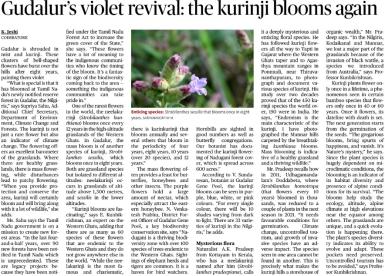
Syllabus Mapping:
- GS Paper 3 – Environment and Ecology: Conservation of biodiversity; ecosystems and their services, Environmental degradation and sustainable development, Role of local communities in environmental protection
- GS Paper 1 – Geography: Flora and fauna of India; distribution of natural vegetation, Human-environment interaction in the Western Ghats.
Context: In a remarkable ecological event, the kurinji flowers (Strobilanthes spp.) have bloomed once again in Gudalur, located in the Nilgiris district of Tamil Nadu, after eight years.
The mass flowering of these bell-shaped violet-blue blossoms is not just a spectacle of natural beauty, but also a crucial ecological indicator reflecting the health of grasslands and climate stability in the Western Ghats region. This year’s bloom, particularly of
Strobilanthes sessilis, has taken place in the newly notified reserve forests of Gudalur, marking a significant sign of biodiversity revival in the area.
About the Kurinji (Neelakurinji) Flower
- Scientific Name: Strobilanthes kunthiana (Neelakurinji)
- Family: Acanthaceae
- Habitat: High-altitude grasslands of the Western Ghats, typically above 1,300 meters.
- Blooming Cycle:
- Neelakurinji blooms once every 12 years.
- Strobilanthes sessilis blooms once every 8 years.
- Other Strobilanthes species bloom in cycles of 4, 8, 10, or 12 years.
- Geographical Range: Found in the Nilgiris, Palani Hills, Kodaikanal, Munnar, and Agasthyamala ranges.
- Etymology: The name “Neelakurinji” literally means “blue flower” (Neela = blue; kurinji = hill region).
Ecological and Cultural Significance 1. Indicator of Grassland Health - The blooming of Kurinji acts as a natural barometer of ecological health.
- Healthy, undisturbed grasslands ensure synchronized mass flowering, whereas fragmented or degraded habitats lead to patchy and irregular blooming.
- Thus, Kurinji blooms serve as climate and ecosystem indicators.
2. Role in Biodiversity - Kurinji blooms attract a wide range of pollinators, including butterflies, honeybees, and hornbills, creating temporary surges in local biodiversity.
- The flowers are rich in nectar, vital for sustaining insect and bird populations during the blooming season.
- The grasslands supporting Kurinji are home to elephants, gaurs, leopards, and numerous endemic plant species.
3. Socio-Cultural Symbolism - The Neelakurinji is deeply ingrained in Tamil and Kerala traditions, symbolizing purity and rarity.
- The Paliyan tribes of Tamil Nadu use Kurinji blooming cycles to measure age — one bloom (12 years) equals one life phase.
- It is also emblematic of the Western Ghats’ natural heritage, often referred to as the “blue mountains” during the blooming season.
Scientific Insights and Ecological Concerns 1. Habitat Loss and Grassland Conversion
- Over the past century, large tracts of grasslands in the Nilgiris and Western Ghats have been converted into plantations (tea, eucalyptus, black wattle, and pine) and solar farms.
- This has shrunk native Kurinji habitats, reducing the frequency and extent of flowering.
2. Climate Change Impact - Erratic rainfall and rising temperatures have altered flowering patterns.
- For instance, the Strobilanthes homotropo in Doddabetta bloomed in 2011 but failed to regenerate due to unfavorable climatic conditions.
3. Tourism and Disturbance - Mass blooming attracts heavy tourist influx, leading to trampling of fragile plants, waste accumulation, and soil compaction.
- Scientists emphasize the need for regulated eco-tourism to ensure the sustainability of future blooms.
The Tamil Nadu Forest Department’s Conservation Efforts 1. Notification of New Reserve Forests: o The Nadugani Reserve Forest in Gudalur was recently declared a protected area under the Tamil Nadu Forest Act, adding over 600 acres to the green cover. o This step aims to restore native vegetation and curb encroachment.
2. Monitoring and Research: o Botanists and forest officers are documenting Kurinji bloom patterns and their correlation with rainfall, altitude, and temperature variations. o Around 33 Kurinji species have been identified across the Nilgiris alone, each with varying blooming periodicities and color shades — from pale violet to deep blue.
3. Community Involvement: o Indigenous communities are being encouraged to participate in conservation by reviving traditional ecological knowledge about plant cycles and sustainable grazing. Ecological Message Behind the Bloom
- The mass flowering of Kurinji is nature’s way of rejuvenating the landscape.
- Once the plants bloom, they set seeds and die, allowing the next generation to germinate.
- This cyclical regeneration maintains soil fertility, moisture retention, and biodiversity stability in the montane grasslands.
- The event thus underscores the importance of protecting grasslands as unique ecosystems, not wastelands — a major gap in Indian conservation policy.
Expert Views - Prof. Supriya Sahu (IAS):
The blooming in newly notified reserve forests signifies biodiversity comeback and reflects improved habitat protection. - Prof. Kunhikrisnan (Western Ghats expert):
Kurinji are indicator species — their presence marks healthy ecosystems. The loss of grasslands is pushing many species towards extinction. - A.K. Pradeep (Naturalist):
Over 150 Kurinji species have been identified globally, of which India hosts 60 — highlighting its endemism and global importance.
UPSC Prelims: Q. Consider the following statements regarding the Kurinji (Neelakurinji) flower: 1. The Kurinji flower (
Strobilanthes kunthiana) blooms once every 12 years and is native to the grasslands of the Western Ghats. 2. It is an indicator species used to assess the health of montane ecosystems. 3. The Kurinji plant is listed under Schedule I of the Wildlife Protection Act, 1972. 4. Its blooming cycle is influenced by climatic and soil conditions. Which of the statements given above are correct?
(a) 1, 2 and 4 only
(b) 1 and 3 only
(c) 2 and 3 only
(d) 1, 2, 3 and 4
Answer: (a) 1, 2 and 4 only
New Development Bank: Pakistan Seeks China’s Help for Membership
Syllabus: GS Paper II – International Relations Context
Pakistan has approached China for assistance in joining the New Development Bank (NDB), which was established by the BRICS nations. The NDB is aimed at funding sustainable development and infrastructure projects in emerging economies.
Key Points:
- Establishment: NDB, formerly known as the BRICS Development Bank, was created by Brazil, Russia, India, China, and South Africa (BRICS) to support infrastructure and sustainable development.
- Headquarters: The bank is based in Shanghai, China, with regional offices in South Africa and Brazil.
- Objective: It aims to mobilize resources for projects related to clean energy, transport infrastructure, water and sanitation, environmental protection, social infrastructure, and digital development.
- Capital Structure: NDB has an initial capital of USD 100 billion, with equal contributions from its five founding members.
- Voting Rights: Each member country holds equal voting power, unlike other international banks such as the World Bank or ADB.
- Governance: The governance structure includes a Board of Governors consisting of finance ministers from the BRICS countries and a Board of Directors. The presidency and vice-presidency rotate among the BRICS members.
- Membership: Open to any UN member, with countries like Pakistan seeking to join through diplomatic channels, notably via China’s support.
Source: [IT News]
We Rise Initiative: Empowering Women Entrepreneurs
Syllabus: GS Paper II – Government Policies and Interventions Context
NITI Aayog’s Women Entrepreneurship Platform (WEP) has partnered with DP World to launch the "We Rise Initiative," which aims to support and scale up women-led businesses in India. This initiative is designed to offer trade facilitation, mentorship, and strategic partnerships to empower women entrepreneurs.
Key Points: - Launch: The "We Rise" initiative was launched jointly by NITI Aayog and DP World under the WEP’s Award to Reward (ATR) initiative.
- Objective: The initiative focuses on helping Indian women entrepreneurs scale their businesses globally through mentorship, trade facilitation, and strategic collaborations.
- Target Group: The initiative specifically targets product-centric women entrepreneurs, helping them expand their reach and market access.
- Public-Private Collaboration: It is a unique partnership between the public and private sectors to increase trade opportunities for women entrepreneurs and foster business growth.
- Women Entrepreneurship Platform (WEP): Established by NITI Aayog in 2018, WEP became a public-private partnership in 2022, aimed at strengthening India’s women entrepreneurship ecosystem.
- Function of WEP: WEP provides comprehensive support to women entrepreneurs, including access to finance, market linkages, training, mentoring, compliance assistance, and business development services.
Source: PIB
Food and Agriculture Organization: 80 Years of Partnership with India Syllabus: GS Paper II – International Relations, Governance Context
On World Food Day 2025, India and the Food and Agriculture Organization (FAO) of the United Nations celebrated 80 years of partnership. This collaboration has played a significant role in promoting food security and agricultural development.
Key Points: - Establishment: The FAO was founded in October 1945 and is the oldest permanent specialized agency of the United Nations.
- Mandate: Its main goal is to improve nutrition, increase agricultural productivity, raise living standards in rural areas, and contribute to global economic growth.
- Functions: FAO coordinates international efforts in agriculture, forestry, fisheries, and land and water resources. It is also at the forefront of global efforts to combat hunger.
- Global Role: The FAO serves as a platform for negotiating agreements and provides technical knowledge to support development in both developing and developed countries.
- Members: FAO has 195 members, including 194 countries and the European Union. India is a founding member.
- Funding: The organization is funded by contributions from its member countries.
- Reports: FAO publishes key reports such as The State of the World’s Forests (SOFO), The State of World Fisheries and Aquaculture (SOFIA), The State of Agricultural Commodity Markets (SOCO), and The State of Food Security and Nutrition in the World (SOFI).
- Headquarters: FAO is headquartered in Rome, Italy.
Source: PIB
IN-RoKN Exercise: Strengthening Naval Ties Between India and South Korea
Syllabus: GS Paper II – International Relations Context
On 13 October 2025, Indian Naval Ship (INS) Sahyadri arrived at Busan Naval Harbour, South Korea, to participate in the inaugural India–Republic of Korea Navy (IN–RoKN) Bilateral Exercise. This exercise aims to enhance the interoperability and coordination between the Indian Navy and the Republic of Korea Navy.
Key Points:
- Exercise Overview: The IN–RoKN Exercise is a bilateral naval exercise between the Indian Navy and the Republic of Korea Navy, aimed at improving collaboration and professional exchanges.
- Exercise Phases: The exercise is conducted in two phases – the harbour phase and the sea phase.
- Harbour Phase: Includes reciprocal cross-deck visits, sharing of best practices, cross-training sessions, and sport fixtures.
- Sea Phase: Joint exercises between INS Sahyadri and ROKS Gyeongnam to enhance operational coordination.
- Diplomatic Significance: The Commanding Officer of INS Sahyadri will meet senior officers from the Republic of Korea Navy, local dignitaries, and Indian community representatives, reaffirming India’s diplomatic and naval outreach.
- INS Sahyadri: Commissioned in 2012, it is a guided missile stealth frigate of the Shivalik Class. Built indigenously by Mazagon Dock Shipbuilders in Mumbai, it is equipped with advanced stealth capabilities, weapons systems, and sensors for multi-dimensional warfare.
- Strategic Importance: This exercise strengthens India’s naval presence and cooperation with South Korea, aligning with India’s strategic interests in the Indo-Pacific region.
Source: DEVD











